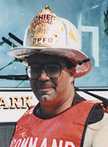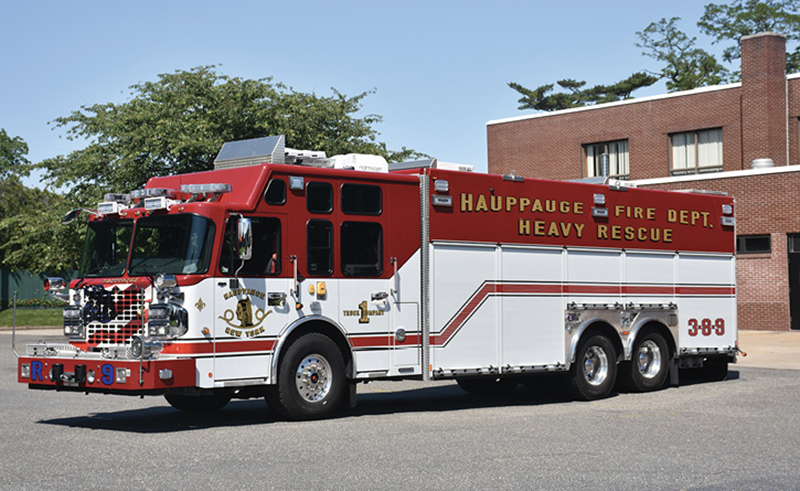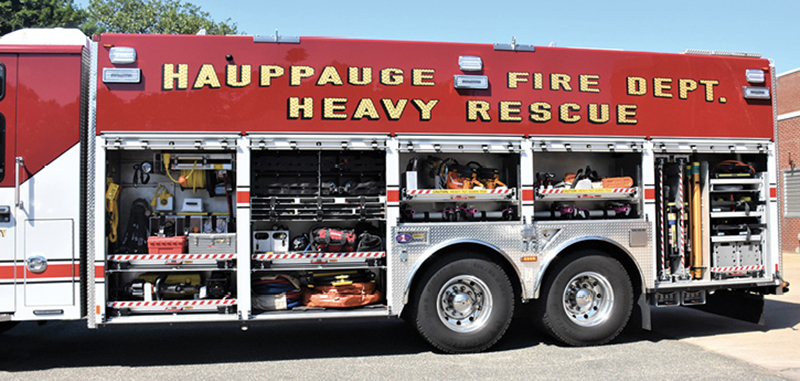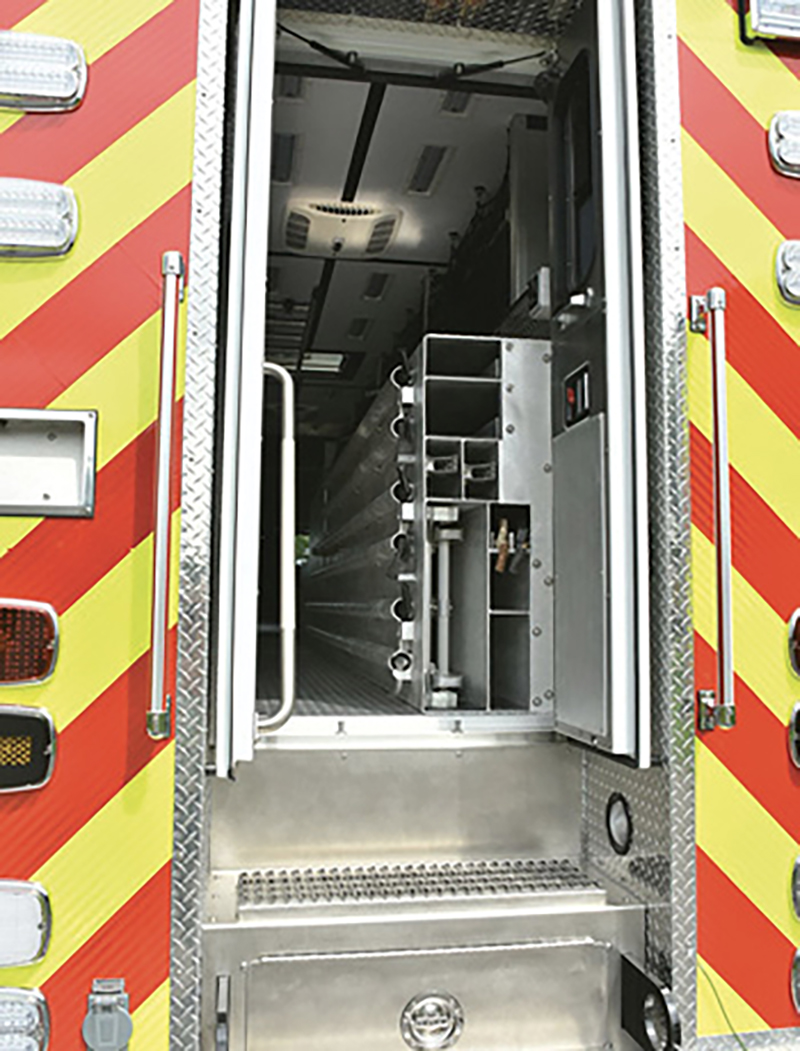
Apparatus ideas BOB VACCARO
The Hauppauge Fire Department, located on Long Island, NY, was created in 1931 at the direction of 14 charter members. Since that time, the community has grown immensely.

It now has five schools, strip shopping centers, restaurants, and hotels and is home to the Hauppauge Industrial Park, the nation’s second largest, with more than 1,000 businesses employing more than 55,000 people. Add this to the 7,300 households and a population of more than 20,000 residents, and you have a response district larger than some major U.S. cities.
The Hauppauge Fire District had kept pace with the community’s growth by being proactive in apparatus purchases in the past several years.
“When it came to designing a new heavy rescue for the department, we wanted to make a great deal of improvements,” Louis Zarra, former chief and present fire commissioner, says. “We were replacing our older rescue, which served the department well since 1999. It was a Spartan Saulsbury with a walk-in body, which we really liked.”
Zarra says the fire district along with the apparatus committee, comprised of senior members, former chiefs, and senior officers, started the design process back in 2017 and looked at several vehicles built with the walk-around concept.
“We wanted these individuals to share their knowledge and opinions so we would have a vehicle built that would work for everyone,” Zarra says. “Eventually, we decided to go, once again, with a walk-in box and the newer Spartan cab and chassis, which worked for us in the older vehicle.”

1 The Hauppauge (NY) Fire Department’s 2021 Spartan/Rescue 1 walk-in heavy rescue. (Photos 1-3 by author.)
Spartan/Rescue 1 Specs
|
He says the larger Spartan Gladiator cab gave the department more room and safety features not afforded in the older Spartan unit. Since Saulsbury was no longer in business, Zarra says the department had to find a new builder for the body.
“We went for Rescue 1 as the builder of the box,” he says. “Rescue 1 is known in the industry for building strong rescue bodies and is also know for its superb tool mounting, which is performed right at the factory.”
As the Rescue 1 manufacturing plant is only two hours from Hauppauge, it was easy for the committee to travel for inspections when necessary, he says, noting that COVID-19 prevented a lot of in-person meetings, forcing a number of Zoom calls and weekly photo submissions to monitor the apparatus building progression. The process was eased as well by the fact that the local dealer, Hendrickson Fire Rescue Equipment, is located within Hauppauge’s response district, according to Zarra, who added the dealer was always available to answer questions before and during the build.

2 Driver’s side compartments carry saws, air bags, struts, and related equipment.

3 Officer’s side compartments carry Holmatro rescue tools, cribbing, fans, and cutting torches.
Learning from experience with the older rescue truck, Zarra says the department decided not to have the body built with underbody compartments, which gave the firefighters problems with curbs. Instead, the firefighters decided to extend the vertical compartments to carry air bags and related equipment, he says, noting the department also decided to add a dry absorbent compartment and roll-out shelving.
Other features built into the new heavy rescue include webbing in the interior areas to contain equipment rather than roll-up doors found in the previous rescue, he says. Included are storage racks for self-contained breathing apparatus, air bottles, air cylinders for use with the air bags and rescue struts, and two independent air hoses with 75-foot and 25-foot extenders.

4 The Holmatro rescue tool compartment has roll-out, flip-out storage. (Photos 4-6 courtesy of Rescue 1.)

5 The unit has an extended front bumper storage with a winch.

6 The rear walk-in box has ladder and pike pole storage.
Hauppauge Fire District
|
“Our committee wanted to utilize the compartment space to its fullest,” Zarra says. “Other equipment carried is a full complement of Holmatro extrication tools, battery and hydraulic as a backup. We also updated to new Power-TEC struts, a 20,000-pound Warn winch with a 10,000-portable Warn winch with three receiver ports on the body.”
Other features of the new heavy rescue include a stainless-steel body and an FRC 360-degree camera system, giving drivers “an extra set of eyes for safety as they maneuver the large, tandem rear-axle truck with an extended front bumper,” Zarra says.
The new rescue also has a Will-Burt light tower, two 200-foot electric cable reels, 12-volt lighting all the way around the body with FRC providing scene lighting, roll-up doors on both sides of the body, a V-Mux electrical system, and a Kussmaul charging system.
When your fire department or fire district is in the process of designing a new heavy rescue, there are many discussions that have to take place within your design committee. Whether this is a replacement vehicle or a brand-new rescue advancing the department’s mission, a lot of decisions have to be made as to the type of body, walk-in or walk around; the size of the body; wiring; lighting; generators; and the design layout of the compartments.
Don’t just load the vehicle up with extra compartment space and have the tools thrown in. Design each compartment with a tool-specific purpose. Also, have the tool mounting done at the factory if feasible or the local dealer for a professional look and for ease and operation of the tool itself. Also do not overload the vehicle. Make sure when you plan out the compartments and mount all of the tools and equipment, it doesn’t go over the gross vehicle weight.
Design with the future in mind. You might know of a target hazard being built in your response area that necessitates your carrying a special type of equipment, even for mutual aid. Because of staffing shortages in the volunteer sector around the country, we are seeing more and more departments responding on an automatic mutual plan.
The Hauppauge Fire Department covered all the bases with this new heavy rescue and was proactive in its thinking. This provided the members with a highly functional and operational heavy rescue, which should provide them with service in the foreseeable future.
BOB VACCARO has more than 40 years of fire service experience. He is a former chief of the Deer Park (NY) Fire Department. Vaccaro has also worked for the Insurance Services Office, the New York Fire Patrol, and several major commercial insurance companies as a senior loss-control consultant. He is a life member of the IAFC.

